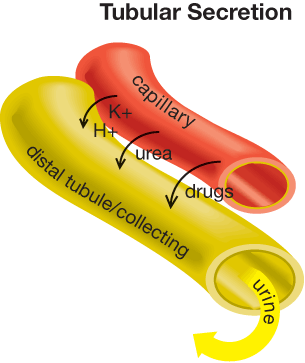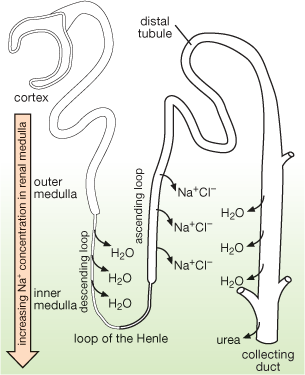Module 8 Intro
1. Module 8 Intro
1.46. Page 3
Module 8—Circulation, Immunity, and Excretion
 Read
Read
Tubular Reabsorption

Inquiry into Biology (Whitby, ON: McGraw-Hill Ryerson, 2007), 312, fig. 9.5. Reproduced by permission.
Filtrate from the glomerulus moves to Bowman’s capsule. From there, the filtrate moves along the proximal tubule where the filtrate is reabsorbed from the proximal tubule through active and passive transport mechanisms (diffusion, osmosis).
Reabsorption, by definition, is the movement of substances out of the renal tubules back into the blood capillaries located around the tubules. The nutrient glucose (blood sugar) is entirely reabsorbed back into the blood from the proximal tubules. Glucose is actively transported out of the tubules and into the capillary net that surrounds the tubule.
None of this valuable nutrient is wasted by being lost in the urine. However, even when the kidneys are operating at peak efficiency, the nephrons can reabsorb only so much sugar and water. Their limitations are dramatically illustrated in cases of diabetes mellitus, a disease which causes the amount of sugar in the blood to rise far above normal.
As already mentioned, in ordinary cases all the glucose that seeps out through the glomeruli into the tubules is reabsorbed into the blood. But if too much glucose is present, the tubules reach the limit of their ability to pass the sugar back into the bloodstream, and the tubules retain some of it. It is then carried along in the urine, often providing a doctor with her first clue that a patient has diabetes mellitus.
The value of urine as a diagnostic aid has been known to the world of medicine since as far back as the time of Hippocrates. Since then, examination of urine has become a regular procedure for physicians as well as for scientists.
proximal tubule: the tubule connected to Bowman’s capsule
Its main function is the reabsorption of water and solutes as well as the secretion of hydrogen ions.
distal tubule: the tubular portion of the nephron that lies between the loop of Henle and the proximal tubule
The distal tubule’s main function is the reabsorption of water and solutes and the secretion of various substances.
loop of Henle: a tubular portion of the nephron
It is an extension of the proximal tubule that loops into the medulla of the kidney and its main function is the reabsorption of water and ions.
The descending loop of Henle reabsorbs mostly water and some ions. The medulla region of the kidney is a salty environment. The cells of the descending loop are permeable to water and only slightly permeable to ions. Therefore, mostly water leaves the filtrate to return to the blood. The concentration of Na+ increases towards the bottom of the loop.
The ascending loop of Henle becomes impermeable to water and slightly permeable to solutes. Sodium ions diffuse from the filtrate to nearby blood vessels. The top of the ascending loop becomes thick walled and ions are transported via active transport. This reduces the concentration of the filtrate and replenishes the salty environment of the medulla.
The distal tubule reabsorbs sodium ions, chloride ions, and water depending on the needs of the body. As a person increases the amount of salt taken into the body, the kidneys decrease the amount of sodium reabsorption back into the blood. That is, more sodium is retained in the tubules. Therefore, the amount of salt excreted in the urine increases. The process works the other way as well. The less the salt intake, the greater the amount of sodium reabsorbed back into the blood, and the amount of salt excreted in the urine decreases.
Tubular Secretion

Secretion is the process by which substances move into the distal and collecting tubules from blood in the capillaries around these tubules. Secretion is reabsorption in reverse.
Whereas reabsorption moves substances out of the tubules and into the blood, secretion moves substances out of the blood and into the tubules where they mix with the water and other wastes and are converted into urine. These substances are secreted through either an active transport mechanism or as a result of diffusion across the membrane.
Substances secreted are hydrogen ions (H+), potassium ions (K+), urea, and certain drugs. Potassium (K+) and hydrogen (H+) ions are actively transported into the distal tubule from the capillaries. Potassium in certain concentrations must be maintained as it is required to transmit nerve impulses. Hydrogen ions need to be balanced in order to maintain blood pH. Too many hydrogen ions in the blood can create an acidic environment, which inhibits cellular function.
Collecting Duct Reabsorption

Adapted from Inquiry into Biology (Whitby, ON: McGraw-Hill Ryerson, 2007), BLM 9.2.2. Reproduced by permission.
Once the filtrate has moved through the entire proximal tubule (loop of Henle), it enters the collecting duct. The collecting duct extends into the salty environment of the medulla. This causes water to move across the tubule membrane by osmosis.
If a person is dehydrated, the collecting duct becomes more permeable to water and more water is reabsorbed in order to conserve water. This process is controlled by hormones. You will explore the role of hormones in Lesson 9. Finally, the filtrate, which is about 1% of the original volume, is now urine and is ready to be moved by the ureters to the bladder.
 Try This
Try This
TR 2. Tubular Reabsorption
Solutes are actively and passively transported from the filtrate in the proximal tubule back into the blood. Go to your Lesson 8 Assignment to complete an activity that tests your knowledge of how filtrate moves through the proximal tubules of the kidney.